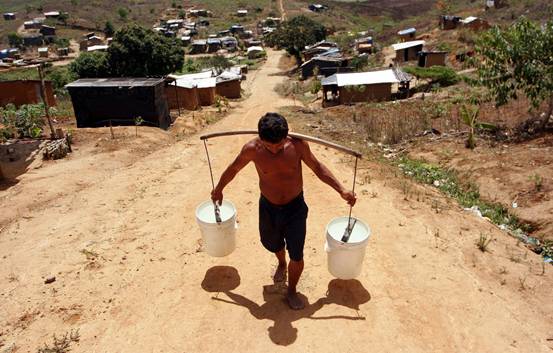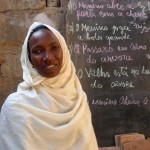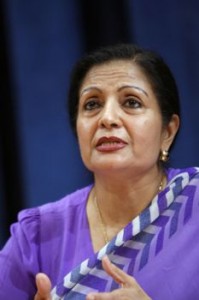I think that it is crucial to take local priorities as the starting point for development co-operation.
Let me give you a very concrete example of why this is important. As mayor of Bagangté Municipality in Cameroon, I developed a project to [...]]]>
I think that it is crucial to take local priorities as the starting point for development co-operation.
Let me give you a very concrete example of why this is important. As mayor of Bagangté Municipality in Cameroon, I developed a project to provide drinking water to my citizens. With support from the International Association of Francophone Mayors, we built a well and held a large campaign to explain the need for citizens to pay taxes to ensure long-term sustainability of the drinking water system.
This was working well, and access to water was increasing. Then all of a sudden, our central government decided to launch a project in my region to provide free drinking water to citizens. This would cancel out all our efforts! I therefore told the government that we already had a programme to provide my people with water access and that this new project was unnecessary and potentially unsustainable in the long term. I am convinced that charging citizens for a service makes them take better care of the network, and ensures long term sustainability, as maintenance will be easier when people feel that the service belongs to them because they pay for it. I explained that if the central government wanted to invest in my community, their support for access to electricity would be far more useful. This example is a typical one.
Unfortunately, the Ministry refused to change or transform their project to improve the existing network.
As a Champion on Development Co-operation for the global organisation of United Cities and Local Governments, a function shared with eight other mayors from around the world, I aim to increase recognition of local governments’ role in development. I see it as my task to feed lessons from my local reality into international discussions on making development co-operation more effective, coherent and accountable.
Local governments are on the front line of dealing with development challenges, and identifying solutions to them. It is only natural that they take a leading role in the elaboration of development strategies for their areas. A formal consultation mechanism should ensure that these are included in national development strategies. What’s more, local governments and their associations should be supported to have the capacity to engage in this dialogue.
Local government development co-operation as effective solution
Let me get back to my example from Cameroon. Our well project was supported by an association of local governments from abroad, with help from experts from other local governments that knew the kind of services we deliver and how to do this effectively. This helped to make the project a success. This “decentralised development co-operation” had a high degree of ownership and local traction, based on my local government’s priorities.
This kind of co-operation between peers is based on long-term relationships, resulting in trust, transparency and good dialogue between partners. This is very important to achieve sustainability. It can be done in a very cost-effective manner since the co-operation initiatives build on the existing local governments themselves and use existing staff within the municipal organisations. This avoids the need to set up parallel structures that could lack the political leadership of the partner itself.
The cost of not working with local governments
Strengthening local governments is crucial to achieve development goals. A top down approach by central government can result in development policies ill-adapted to local needs and contexts. Development partners such as multilateral organisations, states, and civil society should understand that the cost of not working with local governments may be high, missing local ownership, as seen in the case of the water project in Bagangté.
For a start, their action might not be sustainable when not embedded into a local public policy designed to meet the needs of the citizen. Embedding development priorities in local public policy ensures their continuation and follow up because municipal policy is attached to a concrete workplan with a budget. This bottom up process is very important.
There may also be duplication of work at local and national levels, with a risk of confusion on the mandates of different levels of government. Bypassing local government may also generate distrust among citizens.
I believe that local government development co-operation initiatives can provide national governments with a broad range of experiences to help them respond to issues, challenges or disasters that have effects at the local level. It is crucial that local governments become true partners in national dialogues on development priorities, policies and strategies.
It is also important that reviews of development co-operation commitments such as the Busan commitments give more attention to the role of local governments in national debates on development priorities and implementation. It is good that UCLG is back on the Global Partnership for Effective Development Co-operation’s Steering Committee.
I think UCLG should also explore, within the Global Partnership, how the post-2015 development goals will be implemented. It is in this regard important that more focus is placed on who can help achieve which goals, as opposed to just focusing on what should be achieved.
I hope that together we can ensure that the level of government closest to citizens, becomes more equipped to address the upcoming new set of development goals, which should be in line with our own priorities at the local level.
This article is published with the assistance of the Global Partnership for Effective Development Co-operation, more expert comment is available at http://devcooperation.org.
]]>Increasing global demand for energy will affect the already acute fresh water shortage, according to the latest United Nations World Water Development Report (WWDR) launched in Tokyo Saturday on the occasion of World Water Day.
The report highlighted a glaring lack of coordination between energy and water management [...]]]>
Increasing global demand for energy will affect the already acute fresh water shortage, according to the latest United Nations World Water Development Report (WWDR) launched in Tokyo Saturday on the occasion of World Water Day.
The report highlighted a glaring lack of coordination between energy and water management systems, despite the fact that places where people have inadequate access to water largely coincide with those where people have no electric power.

A man hauls water at the Chico Mendes landless peasant camp in Pernambuco, Brazil. Credit: Alejandro Arigón/IPS
More than 750 million people in the world have no access to clean water, and more than a billion people are not connected to an electric power grid.
Improving access to those vital resources means recognising the interdependence of water and energy for sustainable development, said Irina Bokova, director-general of the U.N. Educational, Scientific and Cultural Organisation (UNESCO).
Energy production accounts for roughly 15 percent of water withdrawal annually. By 2035, that number will rise to 20 percent due to population growth, urbanisation, and changing consumption patterns.
Similarly, declining water resources also have direct repercussions on the demand for electricity, which is expected to rise by 70 percent by 2035, mostly due to developments in India and China. Already those two countries are home to the largest number of people without access to water: 108 million in China and 99 million in India wake up every morning knowing it will be a life or death search for that precious resource.
Electric power plants, which produce 80 percent of the electricity worldwide, need large quantities of water for the cooling process. Water is also guzzled during energy production and for the extraction of fossil fuels. Likewise, the collection, transport and treatment of water consume massive quantities of energy.
Meeting the power challenges means creating systems that allow for the combined production and management of water and electricity, concludes the World Water Assessment Programme (WWAP), which produced the report.
The report also provides pricing solutions for the crisis, suggesting that the two resources be sold at rates that reflect more accurately their cost and environmental impact. Current water prices hardly reflect the true cost of provision, keeping in mind that it is an essential resource for all life on earth. Higher prices could encourage energy producers and users to value and save water, experts say.
Improving water and energy efficiency means embracing methods such as energy generation through water recycling. Such projects are already being implemented and are likely to spread in the future. In Chile, for example, the Farafana plant treats 50 percent of the wastewater of Santiago, producing alternative energy for 100,000 residents.
U.N. Secretary-General Ban Ki-moon said Friday that water and energy “interact with each other in ways that can help – or hinder – our efforts to build stable societies and lives of dignity for all.”
Anicée Gohar is a trainee at the IPS United Nations bureau.
]]>by Mitchell Plitnick
There was a real diplomatic blowup in the Knesset last week, when Naftali Bennett led a walkout of the chamber by his HaBayit HaYehudi party during a speech by European Union Parliamentary President Martin Schulz. The comment Schulz made that elicited his response was this: “A Palestinian youth [...]]]>
by Mitchell Plitnick
There was a real diplomatic blowup in the Knesset last week, when Naftali Bennett led a walkout of the chamber by his HaBayit HaYehudi party during a speech by European Union Parliamentary President Martin Schulz. The comment Schulz made that elicited his response was this: “A Palestinian youth asked me why an Israeli can use 70 cubic liters of water and a Palestinian just 17. I haven’t checked the data. I’m asking you if this is correct.”
Is this just another example of Israeli hyper-sensitivity and over-reaction? In fact, it is not. At first glance, this seems like a foreign leader framing a question, one that seems to be regarding an issue that makes Israel look no worse than frequent statements about settlements and foot-dragging on the peace process. It actually touches on an issue that is at the very heart of the Israel-Palestine conflict, but that is too often overlooked. That issue is water.
When one mentions water in conjunction with the Middle East, there is always this “oh, yeah” reaction as people remember that this is probably the single most important issue in the region. But it is too rarely considered in political analyses. It isn’t discussed often enough in the context of the roots of the Israel-Palestine conflict, but it is absolutely fundamental to Israeli policy and Palestinian dispossession.
People are usually puzzled as to why Israel risks international isolation and opprobrium in order to maintain its occupation. Is it religious zeal? Nationalistic fervor? An obsession with security considerations that Israel’s military might has transcended and that are based in military thinking that is a half-century out of date? All of these are very real factors. But somehow, water is never mentioned as more than an afterthought (and I confess, I am as much at fault as my fellows in this regard).
But anyone who has ever been to Israel and also to other countries in the region knows that Israel, although it certainly needs to be more water-conscious than most Western countries, lives a more water-rich lifestyle than any of its neighbors. Talk to older Israelis who remember things before 1967; that was a different Israel in many ways, and water was a big issue. The difference between Israelis and Palestinians in the West Bank and East Jerusalem is even more starkly visible; the contrast between homes with lush lawns and, in some cases, swimming pools in the settlements, and the arid homes of Palestinians with water cisterns on the roofs that are not always filled on schedule and often hold less than what is required between fillings is quite striking.
Today, and for more than four decades now, many of Israel’s major cities get a huge portion of their water from the mountain aquifer in the West Bank. Other water sources in Israel are dependent on this aquifer, and a few other smaller ones in the West Bank as well (see the map here). So not only would abandoning the West Bank mean that Israel loses a major portion of its water supply, the Palestinians would actually have the ability to control the sources of some water that is drawn within Israel’s internationally recognized boundaries.
That’s why water is always a sensitive issue. It’s made more so, of course, because, while the Palestinians and Israel “share” this major water resources, consumption is not at all equal. According to the Israeli human rights organization, B’Tselem, daily per capita water consumption among Palestinians connected to the water grid in the West Bank for domestic, urban, and industrial use is some 73 liters. In areas in the northern West Bank, consumption is much lower. In 2008, per capita daily consumption was 44 liters in the Jenin area and 37 liters in the Tubas area, according to B’Tselem’s statistics. Today it’s about 38 liter per day in Jenin, but 169 in Jericho, which is very close to Israeli usage. About 113,000 Palestinians are not connected to the water grid, however, and their daily consumption is a mere 20-50 liters.
Most Palestinian water consumption is thus considerably lower than the WHO’s and USAID’s recommended bare minimum of 100 liters per day, and considerably less than the Israeli average of about 183 liters per day. So, yes, Schulz overstated it when he said Israelis consume four times as much per capita as Palestinians. They “only” consume between 2.4 and 3.5 times as much, with the gap between the average Israeli and the worst off Palestinian being about 7.5 times as much. And, let’s remember, that this is a resource that Israel took from the Palestinians when they occupied the West Bank. Before that, under Jordanian rule, and for the most part under the British Mandate, West Bank Palestinians enjoyed full access to the water resources in their area.
The conditions described above apply only in the West Bank. In Gaza, the situation is much worse. Gaza depends almost entirely on the coastal aquifer, which is also used by Israel and Egypt. The Palestinian Water Authority pumps more than three times the aquifer’s replenishment rate per year, and even that, due to unreliable supplies of electricity, water supply is erratic on a daily basis.
Over-pumping of that aquifer is a long-term problem, one that pre-dates Israel’s occupation of the Strip in 1967, but is now reaching crisis proportions. According to WHO findings, the Strip is expected to exhaust its supply of usable drinking water in 2016. UNICEF says that at present, 90% of the water from the coastal aquifer is unfit for human consumption. The majority of Gaza’s citizens have to buy water from vendors, with some paying as much as one-third of their income on water.
The pollution of the aquifer will, of course, also have a significant effect on Israelis and Egyptians, even beyond the fact that they will have to find alternative water sources. The World Bank funded the construction of a water treatment plant to alleviate part of this problem, but although the plant has been completed, it stands idle, caught in the middle of a dispute between Israel and Hamas over Israel providing increased electricity to the Strip in order to run the plant (Gaza still depends on Israel for most of its energy needs).
One can expect that Israel will eventually address this issue. The siege has, from the beginning, been carefully managed by Israel to ensure the deprivation of Gaza’s population while avoiding the sort of massive death and illness that might create international outrage and force Israel to act. But the water issue, as it involves both Gaza and the West Bank, threatens to turn into something much greater.
Although some groups, including the International Committee of the Red Cross, had warned years before the outbreak of violence in Syria of the extent of destabilization that the water crisis there could cause, such warnings were not loud enough and went unheeded by all those world leaders (including the Obama administration) who are currently wringing their hands about their “inability” to take action to stop the ongoing civil war there. In the Occupied Palestinian Territories, a similar dynamic is currently underway, and it is complicated by the occupation, the concomitant restrictions on movement and on Palestinian access to water (while Israeli needs have not yet been impacted significantly) and by the continuing and increasingly petty bickering between the Palestinian Authority and Hamas.
The subject of water is therefore a touchy one for Israel on many levels. Not only is it an issue of unequal access to this most crucial of resources, but it also illustrates the difficulties of truly separating Israel and the Palestinians. Indeed, when it comes to water, it will be impossible for Israel to end the occupation and maintain its current standard of living with regard to water. It will also be impossible for any Palestinian entity to survive without significant external investment in irrigation, water treatment, desalinization, and other methods of conserving and treating water. In other words, when it comes to water, it is highly unlikely that Israel and the Palestinians can separate from each other as the Oslo formulation of a two-state solution envisions.
It has often been said that in the 21st century, water will become one of, if not the leading cause of war. That is nowhere more evident than in the Israel-Palestine conflict. The warning signs are all there now, before things spiral even farther than they already have. But water can also become the basis for a pressing need on which Israelis and Palestinians can cooperate. That can lead to a practical solution and, while that can be a single state as some advocate, it can also be a two-state vision, albeit one that is very different from the Oslo formulation. Two states existing in cooperation and mutual dependence is the key to avoiding more conflict and opening the door to healing. That, rather than the obsessive separation of the two peoples, can exist in two states and can lead to peace. Water can either be the spark for increased conflict or the key to a better future for both peoples. This is the choice facing Israelis, Palestinians and, yes, the United States.
Addendum: The Israeli journalist Amira Hass, writing in Ha’aretz, lists some very pertinent and basic facts about the use of water and the massive inequality therein between Israel and the Palestinians. She makes it quite clear that the situation is much more dire than even Schulz realizes and that Israel is going to great pains to ensure that people (including most Israelis) don’t know how bad it is. In any case, the article is essential reading for anyone who wants to understand this crucial issue. It should be accessible, but if people have any trouble, please contact me through my web site and I will gladly send you a summary of the facts Hass relays.
Photo: Rooftop water cisterns in Jenin, a Palestinian city in the West Bank.
]]>Not only is women’s personal development hampered by disproportionate water-collection duties, their [...]]]>
Not only is women’s personal development hampered by disproportionate water-collection duties, their limited access to productive resources (because of gender discrimination), including irrigation, also causes lower food production overall and thus hunger in developing countries.
You want a side of statistic with that? No problem.
Investing in women-owned agriculture businesses could bring the number of the world’s hungry down by 100 to 150 million people.
Sit with that number for a second and then continue reading.
As Thalif Deen recently reported (reiterated yesterday by Lakshmi Puri, deputy executive director of UN Women) women spend more than 200 million hours per day collecting water.
That’s 40 billion hours per year.
71 percent of the water collection burden falls on women and girls.
We all know the popular media image of women water bearers, but the development loss that occurs for women in that act is rarely quantified.
Women’s disproportionate burden of fetching water limits their personal development, productive capacity and community engagement, including school attendance, market activity and their involvement in local leadership and decision-making.This also has negative effects on building and maintaining peace.
Progress has been made on improving secure water supplies in developing countries and reducing walking distances, but “783 million people still remain without access to an improved source of drinking water,” according to Puri.
She emphasised that “Creating a water- and food-secure world requires putting women and girls at the centre of water and food related policies, actions and financing.”
Rather than seeing women as “beneficiaries of greater water and food security,” they ought to be seen as contributors to greater progress.
Puri lists four urgent actions to “unleash their potential” [emphasis and formatting mine]:
1. Women need to be recognised as water managers, farmers and irrigators, who contribute to ensuring sustainable food production and consumption and to safeguarding the environment.
This must be done in laws, policies and through social awareness programmes in communities.
2. Governments and other partners need to ensure that women are empowered along the water and food supply chain, so that their food production and water management roles are supported.
Improvements in infrastructure services— especially water and electricity—can help free up women’s time spent on domestic and care work. […]
3. We need to address the multifaceted gender discriminations in accessing and controlling productive resources.
Women must be provided with technical training on water management, irrigation, rainwater harvesting, and rain-fed agriculture.
4. Women must be recognised as decision-makers in water governance.
This involves reducing membership fees and broadening the mandate of irrigation schemes to acknowledge and include multiple water users.
]]>
Instead of striking a balance between ambition and realism, the MDGs have become [...]]]>
Instead of striking a balance between ambition and realism, the MDGs have become “money-metric and donor-centric”, “meaningless catch-all phrases.”
So says Jan Vandemoortele, a Belgian national, a United Nations senior official and one of the architects of the MDGs, in a thought-provoking article in the July issue of Development Policy Review of the Overseas Development Institute. (read it here)

Unrealistic goal? A crowded classroom in Guinea Bissau...
The author recalls that the MDGs were set up in 2000 as collective targets based on extrapolations of global trends. They are vague by definition; they are not one-size-fits-all.
Instead, one should look at countries’ historical backgrounds, natural endowments and specific problems, then adapt the Goals to each circumstance, as Mozambique, Cambodia and Ethiopia have done.
Otherwise, this puts undue pressure on the poorest countries and, given that most of these are in Africa, nurtures Afro-pessimism.
For example, the global target for education “is not realistic” for countries in conflict, he says.
True, targets do change. For example, water for all in 2015 morphed into the more feasible goal of halving the number of people without clean water.
Magic numbers
A mantra has evolved: if only there were more money and higher economic growth, the MDGs would be achieved. Who is fond of these “magic numbers”? Staff at global headquarters of aid organisations, says the author, because of their “excessive reliance on abstract concepts.” (he should know, with his long career as a top UN official).

..and their teacher. By M. Sayagues
Vandemoortele sees the MDG canon being usurped by interest groups to push their agendas or devalued “as a repackaged call for more foreign aid.”
Rather, the MDG should be a tool to examine disparities and inequities within countries. In his view, the poorest people continue to be excluded. Many of these are women. Without better sex-disaggregated data, the gender dimension of hunger, illiteracy, disease and poverty remains unexposed.
Most progress takes place among the better off, and inequality and inequity keep rising, says the author.
“The targets are often presented as a universal good that will not demand tough policy choices and hard trade-offs among social groups within a country,” he says.
The MDGs should usher in new thinking about inequalities if they are not to miss the point
What do you think? Send us your views.
]]>
